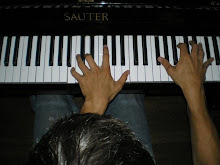I really wonder if I'll ever get over the sheer radicalism of early Glass. This is one of the prettier parts of the 12, despite its true minimalist austerity and constant pulse. The composer once described his music as functioning like wheels in a machine, which makes perfect sense to me. These arpeggios become conceptual spinning disks that morph with the music like clay on a potters wheel.
So to approach this music do we have to be armed with metaphors to describe it? Or can we just listen and enjoy? I think, since the music is so extreme in its forms and unconventional, that the only way to become accustomed to it is to approach it with this mindset. This adds to the music's radicalism, since it has to be understood through a conceptual framework, rather then through standard, accepted formulations, even for a 20th century avant-gardist. I would happily argue that the early work of Glass is some of the most challenging of the century, yet it has opened up avenues of thinking-in-music that never existed before. Suddenly music ceases to follow any western narrative form, no begining, no middle, no end. Music becomes the experience of sounds and rigorous patterns where a chord could be held for 20 minutes. Sustained tones become important-in-themselves, sustained patterns are the music. Change is not a given, it becomes a surprise.
Lahti
2 years ago

No comments:
Post a Comment